Features
Acclaimed baritone Peter Brathwaite was in conversation at the Bodleian libraries this week, as part of its new racial equality event series We Are Our History Conversations. His talk, on the theme of ‘Black Lives in the Archives’, was inspired by his mission to uncover the forgotten and unheard voices of black and enslaved people from history, including those of his own ancestors.
In conversation with Professor Farah Karim-Cooper, Professor of Shakespeare Studies at King’s College, London, the opera star talked about his journey through the Bodleian’s archives to discover his own enslaved ancestors on Barbados – and hear their voices in between the lines of letters which mentioned them just in passing.
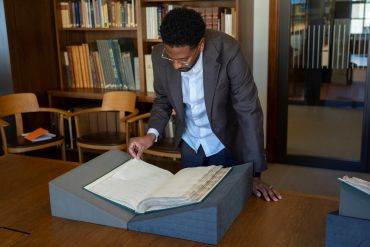 Peter Brathwaite
Peter Brathwaite
He began the project during the pandemic – as he personally reinterpreted dozens of pictures, including one of him as President Obama, as well as him as ancient kings, queens, saints, servants, slaves and even as a Black Madonna. It is both a playful and deeply insightful series. He says, ‘I recreated one every day for 50 days…Black sitters were often unknown or not yet known, as I prefer to say. They needed filling out, a narrative to be constructed and that’s what I was trying to do.’
Peter personally reinterpreted dozens of pictures, including one of him as President Obama, as well as him as ancient kings, queens, saints, servants, slaves and even as a Black Madonna....He says, ‘...Black sitters were often unknown or not yet known, as I prefer to say. They needed filling out...and that’s what I was trying to do
Mr Brathwaite continues, ‘I wanted to hear what they were saying. They had been imagined through the white gaze and I wanted to look at them through the eyes of the sitter.’
It is this approach which has seen the singer engage in months of passionate scholarship in Barbados and in the UK, looking for traces of his ancestors in archives not written from their perspective or even with them in mind.
‘I always had this urge to dig. I wanted to shift the perspective and so I read around the subject extensively,’ he explains. ‘I wanted to learn more about these real people from history.’
His research has proved very successful, although extremely difficult at times, as he uncovered the lives of his enslaved ancestors and learnt more about his forebears.
‘I am descended from white enslaving plantation owners [from whom the name Brathwaite comes] and from enslaved black people…it’s messy, but we think my four times great grandfather, Addo Brathwaite, came from Ghana.’
I am descended from white enslaving plantation owners [from whom the name Brathwaite comes] and from enslaved black people…my four times great grandfather, Addo Brathwaite, came from Ghana
Peter Brathwaite
Clearly passionate to know more, he tells the story of how he found this ancestor named in letters in the Bodleian – revealing a tantalizing glimpse of what may possibly still be uncovered.
Addo had been brought to the West Indies to be a field slave, he became a house slave, and eventually was a free person of colour. Through his research, Peter has found, Addo and his wife Margaret, who was of mixed race, worshipped at the local black church – a fact noted in the Bodleian letters. When he came upon the letters, he was stunned to discover they mentioned his ancestors by name and revealed the couple were seen by the author as respectable examples for the enslaved people of the island.
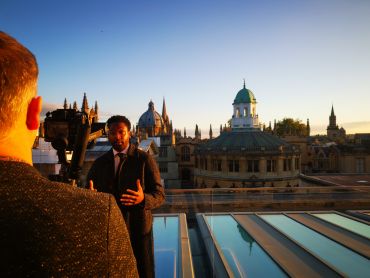 Peter Brathwaite at the Bodleian
Peter Brathwaite at the Bodleian
But, says Peter, by reading against the grain, he tried to find the real Addo and Margaret and the submerged West African culture from which Addo had been taken.
‘Going to church was not just an expression of their faith, but also of the new society in which they lived. But there are hints of the culture: the fact that in Ghanian tradition, women are keepers of generational knowledge and Margaret established the tradition of having a family festival on 2 July each year – which is still going and is similar to the Yam festivals in West Africa. And they established a family village in Barbados, for their extended family.’
There are hints of the submerged culture: the fact that in Ghanian tradition...they established a family village in Barbados, for their extended family
Peter Brathwaite
Also, he says, for the festival, Margaret asked for the hymn ‘Hark, my soul! It is the Lord,’ which was written by a well-known abolitionist.
Peter discovered Margaret had been freed by her own half-brother, John. Their father was one of the infamous Brathwaite’s, who Peter says, it has been hard to avoid in his research. The young John had attended Christ Church – and Peter wonders if he ever brought Margaret to Oxford with him, as did happen with favourite slaves.
‘It’s pain-staking work,’ Peter says earnestly. ‘But you can find little nuggets. It’s really important for people to hear this. If you move away from the data, you can find the people behind the numbers.’
It’s pain-staking work...But you can find little nuggets. It’s really important for people to hear this. If you move away from the data, you can find the people behind the numbers
Peter Brathwaite
When he stumbled on the names of his own ancestors, Peter had been stunned, ‘To turn the pages and absorb - the effect was incredible. It was an encounter with the archives.’
But, he warns, it was something that needs to be done with care because of the ‘visceral violence’ and challenging terminology of the historic papers. He says, ‘It is not easy.’
Jasdeep Singh, Project Manager for the Bodleian’s We Are Our History initiative, explains how the libraries are working to reveal hidden stories in the archives and make them more publicly accessible, with the project, ‘We’re taking a fresh look at imbalances in the collections. From digitization to exhibitions, we’re looking at the impact of the colonial era in the libraries.’
Royal Opera House, 'Insurrection A Work in Progress' by Peter Brathwaite. Highlighting Barbadian folk traditions as a form of resistance.
Photo Credit: Sama Kai
Most of the colonial papers dominated by the voice of officials, researchers in this area are often left with fragments of history that detail the silenced voice...But sometimes, those fragments are brought together by people like Peter. When these surface, they make really powerful stories
Jasdeep Singh, Bodleian libraries
Peter concludes, ‘Not everyone can find their family history. You feel in the dark and grasp at little clues. So much is lost. There is an overwhelming silence. It is deafening.’
The Bodleian's We Are Our History project was inspired by the famous James Baldwin quote: 'History is not the past. It is the present. We carry our history with us. We are our history....'
For further information about the We Are Our History work, and conversations series visit the project website here: We Are Our History | Bodleian Libraries (ox.ac.uk)
Professor Andy Hector describes a unique living resource, Wytham Woods, and how this contributes to the distinctive and immersive learning experience for students at Oxford.
Four miles northwest of Oxford’s city centre lies 1000 acres of woodland and grassland – an outdoor living lab for Oxford’s students and academics. Owned and maintained by the University since 1942, Wytham Woods is home to over 500 species of plants, a wealth of woodland habitats, and 800 species of butterflies and moths.
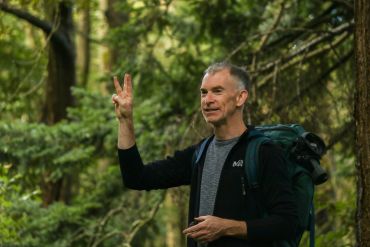 Professor Andy Hector at Wytham Woods (c) Monica Gujral
Professor Andy Hector at Wytham Woods (c) Monica GujralNow entering its eight year of data collection, the project, he says, relies heavily on Oxford’s students: “The Masters and the PhD students in particular, are really key to keeping the research going. Of course, it does mean projects need to be fairly unique. We can't just keep repeating the same things over and over, so it does pose the challenge of coming up with new ideas, and they have to be ones that the students are also interested in.”
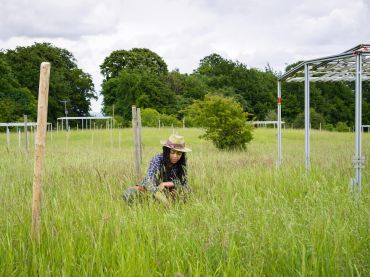 PhD student Sara Middleton at the field site (c) Steven Pocock/Wellcome Collection
PhD student Sara Middleton at the field site (c) Steven Pocock/Wellcome CollectionEqually, Professor Hector says, Wytham is important for PhD students who in general have relatively limited time and resources: “If you’re at a university that’s lucky enough to have an outdoor laboratory, which is what Wytham is to us, then we can have these long-running studies. The students can come in and hit the ground running and take advantage of all the past investment and long-running studies undertaken there.”
One of those students is Sara Middleton, a doctoral researcher in plant ecology and drought, who has been focusing her research on one specific species of grass within the ecosystem and is currently writing up her PhD thesis.
 Undergraduate biology students on their orientation day (c) Monica Gujral
Undergraduate biology students on their orientation day (c) Monica GujralFrom 2020, the Department of Biology has offered an optional research-focused fourth year as part of an integrated masters and many choose to complete their field-based work at Wytham Woods.
So, what do students think when they visit Wytham? “Students react in different ways to Wytham”, says Professor Hector. “The undergraduate biology degree at Oxford is incredibly broad so you will have students with an interest in genes and cells to those who are more interested in organisms, whole ecosystems and conservation. Some people haven’t spent a lot of time outdoors, which can be challenging if the weather is not good. For others you can tell that they are delighted they can take advantage of this outdoor lab right on our doorstep, and interestingly by having a go some people might reconsider what appeals to them.”
What’s the best time of year there? “So as an outdoorsy person, I actually like Wytham at all times of the year! Even in February, with the leaves off the trees you can really see further through the vegetation. If I had to pick - June or July - before the hay is cut and it’s really looking at its best with most of the flowers in bloom”.
Find out more about Wytham Woods here.
- Randomised control trials in Kenya, show cash payments most effective at delivering aid where it is needed
- Based on the research, during pandemic, the South African government used cash payments to reach 28 million people - far more than possible with food parcels
- Researcher Dr Kate Orkin, who led the trials, which saw 5.5 million kept out of food poverty, has been nominated for an ESRC Impact Award.
Nearly 10 million South Africans were going to bed hungry in the early chaotic days of the COVID-19 pandemic. With a hard lockdown in place and some three million people thrown out of work, it was proving impossible for the government to deliver adequate food parcels to the overwhelming majority of those in need. The logistics involved were simply unfeasible.
But based on some new university research, led by Oxford’s Dr Kate Orkin, the South African government did the unthinkable: they gave cash to those in need, and not just a little amount, but large sums of money to support families over the months of the crisis.
There is a stereotype of how people in poverty behave. But, studies have found, this is simply not accurate. People think really hard about the best way to spend the money
Dr Kate Orkin
Not only did the resources reach those in need, it enabled them to buy food, plan for the future and for children’s education.
It was an enormous success and Dr Orkin and her team have been nominated for a prestigious ESRC impact award – for social science research which makes a difference in the world. And it did make an enormous difference.
Together, the team’s recommendations in terms of cash payments influenced spending of ZAR 97.5bn (£4.87bn) which reached 28.5 million people in South Africa, helping to avert a national disaster. Research has shown recipients were both able to provide for today and plan for tomorrow – buying food, setting up businesses, finding new work.
It had been widely believed food parcels were the best way to alleviate urgent need – especially in the developing world. The argument went that, if you gave cash to people in need, they would simply squander it.
But Dr Orkin’s research, based on formal randomised control trials in Kenya, showed that, far from squandering cash, poorer people used it carefully and wisely to improve their lives. And it had wider benefits, even helping those who did not receive the cash, because the money was spent locally.
Dr Orkin says, ‘If you give people the money, it gives them autonomy and they use it for the things they need, including food and healthcare.
The South African government was able to reach more people more quickly...Food parcels can end up being the wrong food and they are so difficult to provide in huge numbers and they can undermine local vendors
Dr Kate Orkin
‘There is a stereotype of how people in poverty behave. But, studies have found, this is simply not accurate. People think really hard about the best way to spend the money.’
She explains, ‘Many people made long term investments – putting a steel roof on their house – or starting a business. The trials we had run in Kenya had shown this to be the way to deliver aid, rather than food parcels.’
‘The South African government was able to reach more people more quickly,’ she says. ‘Food parcels can end up being the wrong food and they are so difficult to provide in huge numbers and they can undermine local vendors.’
According to Dr Orkin, similar trials had been conducted elsewhere internationally and similar programmes were run in various locations, including Colombia and now aid agencies, including UNICEF and ICRC are adopting the same approach.
‘It wasn’t all us,’ she laughs. ‘There is strong evidence from other trials as well.’
‘It was a big shift for the South African government, though,’ says Dr Orkin. ‘They switched to cash emergency aid and reached more people immediately. Previously, they had delivered one million food parcels in a week. The cash reached more than 28 million in five weeks and kept 5.5 million people out of food poverty.’
It was a big shift for the South African government...Previously, they had delivered one million food parcels in a week. The cash reached more than 28 million in five weeks and kept 5.5 million people out of food poverty
Academic research has previously been recognised to provide answers and solutions to many great scientific questions and problems. But the ESRC award is to recognise that social science researchers can also provide real-life impact. In this case, it put paid to a widely-held and long-lasting belief. Randomised control trial evidence transformed lives in the most difficult circumstances.
This summer, 127 students from across the UK came to Oxford to participate in UNIQ+ - the university's flagship graduate access programme that provides students from underrepresented or disadvantaged backgrounds with the opportunity to experience life as a graduate research student. The 7-week programme sees students undertake a research project and attend training skills and information sessions, as well as meeting and working with Oxford researchers, academic staff, and graduate students.
Here we hear from UNIQ+ supervisor David Gavaghan, Professor of Computational Biology at Oxford, and his 2023 UNIQ+ interns, Talal and Kamil, to find out more about their experience of the programme.
Professor Gavaghan, can you tell us about your role at Oxford?
This is my 37th year at Oxford - I came in 1986. I came here for one year to do a master's degree and never quite escaped, although it’s quite a nice place to get stuck!
I particularly work with industry, so looking at how we can use computational biology to establish whether new drugs are likely to cause toxic side effects on the heart and the way that disease spreads, for instance during the Covid-19 pandemic. An academic project I have looks at whether we can engineer bacteria to produce hydrogen and oxygen from waste products which would help tackle climate change. A huge range of things, and what ties it all together is that the mathematics is pretty much identical for all of those things, surprisingly!
My main job these days is running the Doctoral Training Centre, which has four different programmes for DPhil students. We take around 100 students a year and we try and get them to work on problems in the life and natural sciences, with students coming from the complete range of science backgrounds.
How are you involved in UNIQ+?
I’m Chair of the Graduate Access Working Group at Oxford, which has been going for about four years now. One of its first initiatives was UNIQ+, to support underrepresented groups and socio-economically disadvantaged undergraduate students from the UK. This is our fourth iteration of the internship programme. We started with thirty-three students in 2019 and then Covid happened, so the second year was a scaled back digital programme and we had about 115 students. In 2021, we ran a mostly online internship programme, then in 2022 and 2023 we’ve been able to open the programme to 130 students.
You’ve also been supervising two UNIQ+ interns this summer. What have you been working on? 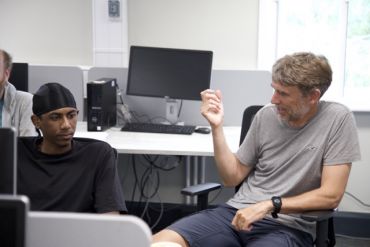 Professor Gavaghan and UNIQ+ 2023 intern Kamil
Professor Gavaghan and UNIQ+ 2023 intern Kamil
What do you enjoy most about being a supervisor?
Getting to interact with the students. They’re so enthusiastic, they’re enjoying being in Oxford, they’re working hard and clearly getting a lot out of it. The point about UNIQ+ is that students who are under-represented in graduate study at Oxford come here and discover that it’s just like any other university. It’s just a really good university and a great place to study. That’s the thing I like best about it. One of the goals is that everyone who has the potential to succeed here considers it as somewhere they might go.
Do participants tend to go on to graduate study?
It varies from year to year. It is certainly making them think hard about whether they want to do graduate study, and that’s one of the interesting things - if they’ve already got a job - whether they’ll come back later and do graduate study having done this. It might put it in their heads.
Before arriving in Oxford for UNIQ+ Kamil had been at UCL studying Computer Science, and Talal had been studying Discrete Mathematics (Maths and Computer Science) for his undergraduate degree at Warwick University.
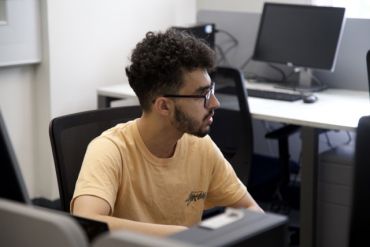 UNIQ+ 2023 intern Talal
UNIQ+ 2023 intern Talal
Talal: No, this is actually the first time. I think I visited Oxford when I was quite young on a year 9 or 10 trip, but this is the first time I've come to Oxford by myself and explored the city.
Kamil: I was born and raised in Northampton, so not far from here. I did the undergraduate UNIQ programme at Oxford before going to university and that's one of the reasons I applied for this because it seemed like that natural progression.
Could you tell us a bit about the research you've been doing over the last seven weeks?
Talal: The first week was training. The thing I really enjoyed was that it was structured in a way that if you wanted to do the more advanced topics, if you were comfortable with the easier topics, you could go ahead and do that. Then after that we pretty much got straight into the research.
Usually you have information and from that you produce data, but in our project we were given the data and we're essentially going backwards to produce the information. So for the bubonic plague that would be trying to find out what the contraction rate was for the plague, the average life expectancy, the mortality rate.
Kamil: The project was to understand the problems faced by people doing statistical inference for the first time, so we were kind of thrown in at the deep end and left to work it out for ourselves. So there was a lot of trial and error, and just trying things out. We got better at recognising what does work and going in the right direction. Now I see why a lot of the things we tried didn’t work!
Why computational biology? What was it about this study area that you were interested in?
Talal: I really wanted to get into something that had a machine learning aspect to it because I have a general interest in that. All the projects that I've done have really just been focused on pure computer science and mathematics and I thought that maybe delving into the biology aspect and looking at computer science in a different way would give me the skills to expand my palette. And I thought it'd be really interesting to see how computational biology actually works.
Kamil: It was similar for me as well. I’d not had any experience with computational biology and I didn't really even know what it meant when I applied for it. But at UCL I found that I liked to apply the maths that I learnt rather than just learn the maths, and so the project itself gave me a good opportunity to do that.
What’s been your highlight over the past seven weeks?
Kamil: I have liked the formal dinners. I think it's a normal College experience for a student here, but it's something different because at most universities in the UK they don't have this kind of thing. It's a lot more chilled than doing the project all the time - there are plenty of events for you to meet other interns and loads of opportunities to socialise.
Talal: Yes, I’d definitely say the same. The dinners, they really were spectacular. Going into the colleges and seeing the inner halls and the traditions of every college is quite remarkable. And you also get to meet everyone else from the programme as well as DPhil students and professors.
Has anything particularly surprised to you about UNIQ+ or about Oxford itself?
Kamil: There's a lot of support by the supervisors. They all clearly know their field very well. Some of the concepts are hard to grasp, which I expected, but it's definitely doable.
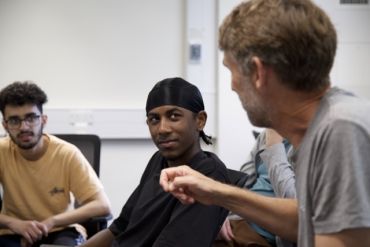 UNIQ+ supervisor David Gavaghan and interns Kamil and Talal
UNIQ+ supervisor David Gavaghan and interns Kamil and TalalTalal: I think I was just surprised about how big Oxford University actually is and it's really nice how it's incorporated within the city. You have access to so many libraries. However you’re feeling you can always find a different place to study, which I really like because I was used to just having one library to go and study.
What would you say to somebody who's thinking about applying for the programme and wondering if it's for them?
Kamil: If you've got a genuine interest in any of the projects you should apply. Even if you don't have much knowledge going into that project, still apply. Talal and I didn’t have knowledge of computational biology and we've done just fine. I’d also say that the application process was quite easy and concise.
Talal: The worst thing that can happen is that they'll say no, but if you ever feel like you shouldn't apply because you feel like your application’s not going to be strong enough, I would highly disagree with that. It’s open for everyone that has interest in research.
What your plans are for the future?
Talal: I'm doing a masters apprenticeship after this. I knew I wanted to do a masters but coming here and speaking to the DPhil students, I definitely want to think about doing a DPhil in the near future, after I've done my masters and maybe worked for a bit and saved up a bit of money.
Kamil: After graduating, I'm going to go to Microsoft as a software engineer. But I still want to keep the doors open for postgraduate study. UNIQ+ has convinced me that maybe I should take that route. I definitely wanted to apply for a masters, but the internship’s swayed my way more to a DPhil as well. But that's all in the future, I haven’t thought too much about it yet.
Find out more about UNIQ+ here.
When it comes to saving the world’s most trafficked wild species – Dalbergia, the rosewood tree- two things are absolutely essential.
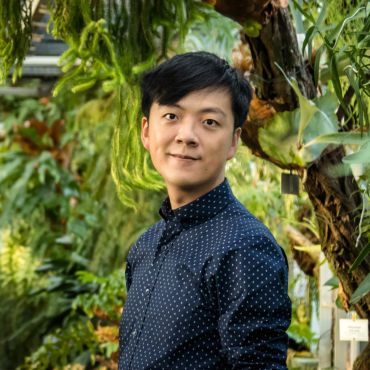 Dr Tin Hang (Henry) Hung. Credit: Henry Hung.
Dr Tin Hang (Henry) Hung. Credit: Henry Hung.You also need vision, because there are no simple ‘quick fix’ solutions. As Dr Tin Hang (Henry) Hung from the University of Oxford’s Department of Biology, says: ‘The rosewood trade is deeply complex, involving many different actors across multiple countries, including indigenous people who depend on selling forestry products to survive. Any attempt to restore rosewood populations therefore needs to be a collaborative approach that addresses the underlying issues fuelling this trade, particularly extreme poverty.’
Fortunately, the rosewood tree has a team of highly ambitious and driven champions. Over the past six years, University of Oxford researchers have supported a project that has brought together plant geneticists, forestry workers, conservationists, local communities, and indigenous people in the race to save the rosewood. By combining local knowledge, forestry management techniques, and cutting-edge plant genetics, these efforts have reduced the pressures on wild rosewood populations, whilst developing pioneering new tools to support conservationists. In combination, this work has provided, as Henry says; ‘a blueprint for how conservation should be done – using approaches that restore wild species while empowering local people through sustainable livelihoods.’
‘Nature has no borders’
This project has really demonstrated the power of the collaborative approach and the benefits of conservationists working with University of Oxford researchers. This will support the Department of Forestry to improve rosewood tree plantation, and also the Department of National Parks, Wildlife and Plant Conservation to make decisions on the best practices for rosewood conservation.
Dr Voradol Chamchumroon Head of Department at the Forest Herbarium, Department of National Park, Wildlife and Plant Conservation, Thailand
Henry’s fascination with rosewoods began as a DPhil student researching genetic diversity of Dalbergia populations. ‘I have always been fascinated about the connections between trees and people’ he says. ‘Trees are fundamental to our survival and restoring forests will be crucial for both mitigating climate change and conserving biodiversity. But many species have been overexploited to the point that they are now endangered. For instance, my home city Hong Kong is thought to be named after the fragrance tree Aquilaria sinensis, which was historically ubiquitous but now at risk of extinction.’
During his studies, Henry became deeply concerned about the speed at which rosewood forests were disappearing. In 2018, this motivated him to join a new rosewood conservation consortium set up by his DPhil supervisors Professor John MacKay and Dr David Boshier in partnership with the Alliance of Bioversity International and CIAT, the University of Copenhagen, and national research institutions from five countries in the Greater Mekong sub-region.* This had been launched with funding from The Darwin Initiative: a UK government grants scheme which aims to help protect biodiversity and the natural environment.
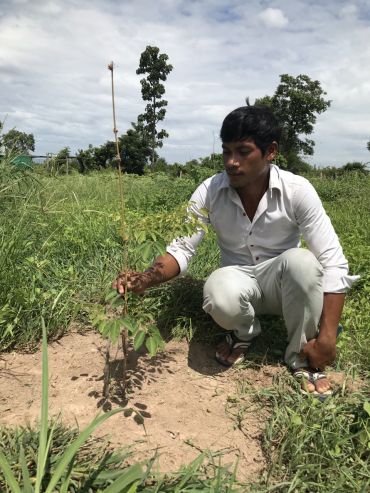 Cambodian farmer Mr Sok Em with rosewood seedlings established on his farmland. Credit: IRD, Cambodia.
Cambodian farmer Mr Sok Em with rosewood seedlings established on his farmland. Credit: IRD, Cambodia.Such an ambitious project would require all stakeholders to be engaged, if it was to have any chance of success. The project team set about creating a network of contacts within forestry offices, national park authorities, conservation organisations, local communities, and indigenous peoples in four countries across the rosewood’s native range: Cambodia, Laos, Thailand, and Vietnam. These were all brought together for stakeholder workshops (in-person to start with, but successfully transitioned online when the COVID-19 pandemic struck).
‘Rosewood species are severely threatened across all countries in their distribution range, so collaboration between countries is paramount to conserve their remaining diversity’ says Dr Riina Jalonen from the Alliance of Bioversity International and CIAT. ‘By bringing together all stakeholders, this enabled networking and the exchange of valuable information and experiences in rosewood conservation and management.’
‘When you have such a large number of different stakeholders, often with different interests, it can be difficult to coordinate effective actions’ adds Henry. ‘In these situations, academic institutions such as the University of Oxford can play an important role by acting as a “glue” to bring people together, build trust, and facilitate knowledge exchange.’
Solving two problems with one action
The pressure on these rosewood species is immense, from illegal logging, habitat destruction and climate change, and it is no longer likely their populations can recover in their natural habitats without interventions. This study is an important step towards recovery of two of the world's most trafficked species and provides a model for the conservation of other endangered tropical tree species too.
Dr Ida Hartvig, Biologist, University of Copenhagen
Through engaging this wide network, it became clear that there was an opportunity to address local needs alongside conservation goals. In many of the regions where rosewood is naturally found, particularly mountainous areas unsuitable for agriculture, poverty levels can be high. However, the team knew from a previous small-scale project that local people could be supported to collect rosewood seeds and grow seedlings as a source of secondary income. This created a way to achieve two goals at once: generating local sources of rosewood seedlings for conservation, whilst providing sustainable livelihoods.
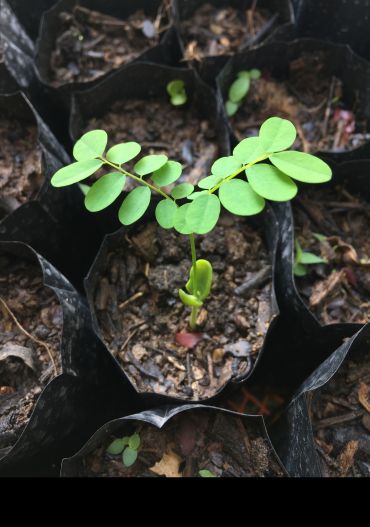 A Dalbergia oliveri seedling. Credit: Shutterstock.
A Dalbergia oliveri seedling. Credit: Shutterstock.Because financial empowerment is inextricably linked with gender equity, a key goal for the project was to improve gender representation within the forestry trade. ‘Traditionally, the forestry trade is very male-dominated as this can involve travelling to remote locations, climbing trees, and being exposed to dangerous animals’ says Henry. ‘Rosewood farms offer women a more accessible means to benefit from this industry.’ Consequently, the project team ensured that at least a third of the indigenous people trained in each country were women.
Within just three years, and despite the challenges created by the COVID-19 pandemic, this approach had already had a significant impact on boosting local incomes. In Cambodia, for instance, communities supported by the project saw average income from selling rosewood seedlings almost double from $300 to $569 a year. For one of the largest nurseries, in the Pursat region of Cambodia, improved methods led to an almost doubled production, from 40,000 to 90,000 rosewood seedlings annually. Besides reducing the pressure on wild rosewood populations, these nurseries also provide a local source of seedlings for reforesting projects.
You can learn more about the threats facing rosewoods and the project to save them in this video produced by Alliance of Bioversity International and CIAT.
Breaking a genetic bottleneck
The project is a rare example of the value of close collaboration between government staff, practitioners and conservationists working on the ground and geneticists. Engagement of local staff and field researchers enabled collection of DNA samples from remnant populations, the University of Oxford researchers performed the genetic analyses and made the results available including as a web-based tool useful in the next generation of hands-on conservation efforts for these precious species.
Dr Ida Theilade, Plant Geneticist, University of Copenhagen
Simply planting more trees, however, won’t be enough to secure the rosewood’s future. With wild populations having been so decimated, low genetic diversity can be a major concern as this reduces seed production, seedling survival, and growth. Furthermore, the effects of climate change mean that trees planted today may not be suited to conditions in the near future. This meant that a key priority for the project was to map the remaining genetic diversity to identify “genetic hotspots” to prioritise for conservation.
Through the network of partners, the project sourced over 800 samples of rosewood leaves from across Southeast Asia which were then sent to Henry in Oxford for DNA sequencing. These included new collections gathered by the partners over the past few years, and also archival collections from Dr Ida Hartvig at the University of Copenhagen from the last decade. ‘It was very sobering to realise that for some of the samples, the original populations in the field had already disappeared, and I was now handling the last remnants of their genetic material’ says Henry.
The first step involved producing the first-ever reference genome for Dalbergia cochinchinensis and Dalbergia oliveri. These were used as baselines for measuring genetic variation among the samples. The genetic data was then combined with geographic information to generate comprehensive distribution maps of rosewood genomic diversity. ‘Notably, this revealed that coastal regions have especially high levels of local adaptation, making them a conservation priority’ says Henry. ‘This may possibly be due to their exposure to more variable environmental conditions on the coast, and their distance from core inland populations may also have allowed them to evolve new genetic diversity at the frontier of the species’ range.’ Using these insights, the project team established 23 new conservation units, creating new jobs for local people as forestry and conservation officers.
Today’s seeds for tomorrow’s forests
If we want the impacts of this work to be self-sustaining, we have to empower conservationists, policy makers and local people to use genetic data as a tool to aid conservation decisions. So right from the start, we were committed to developing user-friendly and open-access online tools to support decision making.
Dr Tin Hang (Henry) Hung, Lead Author & Project Co-Lead, University of Oxford
Building on this, Henry applied this “treasure trove” of genetic data to investigate which genes were intricately linked with environmental adaptation. This identified genetic variants that were strongly associated with environmental variables, such as average rainfall levels and temperature variation. These findings enabled the team to project the "genetic offset" for different rosewood populations, to understand the mismatch between present genetic adaptability and anticipated climate scenarios up to 2100 (recently published in the journal PNAS).
‘Because the effects of climate change are happening so quickly, local rosewood populations will not have time to evolve and adapt by natural selection’ explains Henry. ‘This means that assisted migration will become an increasing focus within conservation, where populations are intentionally established beyond their historic range to track areas with suitable habitat through a period of change.’
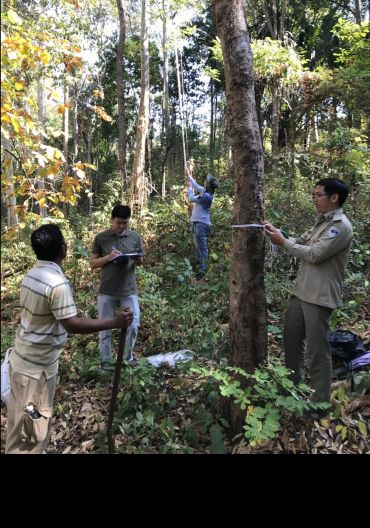 Workers from the Institute of Forestry and Wildlife Research and Development in Cambodia map and measure Dalbergia oliveri seed-producing trees. Credit: IRD, Cambodia.
Workers from the Institute of Forestry and Wildlife Research and Development in Cambodia map and measure Dalbergia oliveri seed-producing trees. Credit: IRD, Cambodia.Alongside this, the genetic database was developed into a bespoke online application called seedeR: a seed-selection tool for rosewood farmers, conservationists, and forestry workers. ‘It is a very user-friendly tool. You simply input the latitude and longitude of a location and it will calculate the most suitable seed source based on the predicted conditions in fifty years’ time’ says Henry.
‘All too often, genomic technologies are inaccessible to conservationists due to a lack of genomics expertise, state-of-the-art technologies, and resources’ he adds. ‘But we have demonstrated that through connecting people and focusing on the needs of end-users, genomic technologies can directly support rapid decision-making and conservation activities.’
With the seedeR interface requiring no specialist knowledge, conservationists are not the only ones who will benefit, as plant geneticist Dr Ida Theilade (University of Copenhagen) explains: ‘To many low-income households, farming rosewood trees acts as a security in times of financial crises and shocks, including for female headed households. As a publicly accessible tool, seedeR will help farmers select seed sources matching planting sites and thereby secure better income from family-based tree-planting activities.’
Hope for the future
This project has highlighted natural adaptations in rosewood trees, and specifically matched genetic diversity to environmental conditions. Genomics research has improved our understanding and given us a toolkit to effectively conserve adaptation potential in remaining trees under a changing climate.
Professor John MacKay, Senior Author & Project Co-Lead, University of Oxford
With new funding from a National Geographic Society grant, Henry intends to confirm the gene-environment associations by growing seedlings under controlled conditions, and identifying which genes are expressed differently in response to environmental stresses. ‘Ultimately, we hope to develop genetic markers so that varieties with key desirable traits, such as drought tolerance, can be identified with a simple genetic screen rather than having to grow them in the field, which takes many years. This would massively accelerate conservation efforts, by reducing the time needed to identify optimum varieties’ he says.
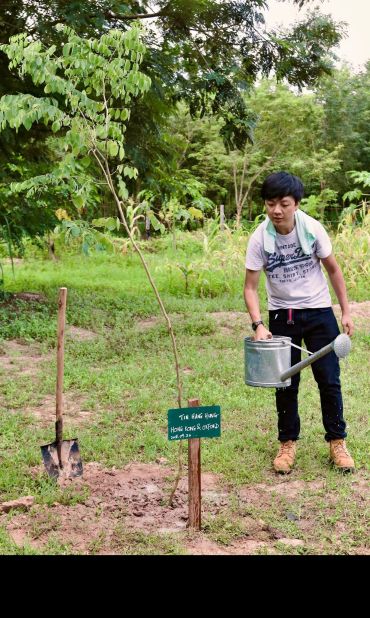 Henry planting a Siamese rosewood tree (Dalbergia cochinchinensis) in Cambodia, September 2018, to commemorate the launch of the project. Credit: Henry Hung and David Boshier.
Henry planting a Siamese rosewood tree (Dalbergia cochinchinensis) in Cambodia, September 2018, to commemorate the launch of the project. Credit: Henry Hung and David Boshier.‘I, for one, am really grateful to my DPhil supervisors John and David, all my collaborators, and all the people living on the land of Mekong who have inspired my research today’ he adds. ‘Forests in southeast Asia nurtured me to become a forest scientist, and I still want to be one for many decades to come. Hopefully some day in my career, I will see rosewoods delisted from the IUCN Red List.’
The study ‘Range-wide differential adaptation and genomic offset in critically endangered Asian rosewoods’ has been published in the journal PNAS.
*The project ‘Conserving Rosewood genetic diversity for resilient lives in the Mekong’ was led by the University of Oxford in partnership with the following organisations: the Alliance of Bioversity International and CIAT; the University of Copenhagen; the Institute of Forest and Wildlife Research and Development of Cambodia; the National Agriculture and Forestry Research Institute of Lao PDR; the Vietnamese Academy of Agricultural Sciences; the Department of National Parks Wildlife and Plant Conservation of Thailand; the Chinese Academy of Forestry.
- ‹ previous
- 5 of 248
- next ›
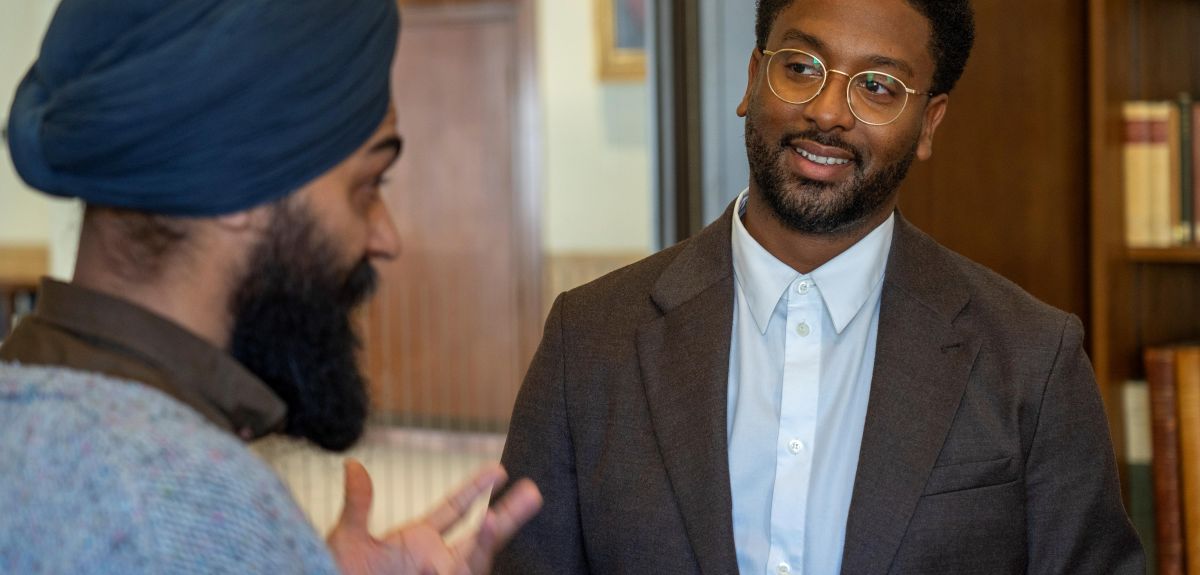
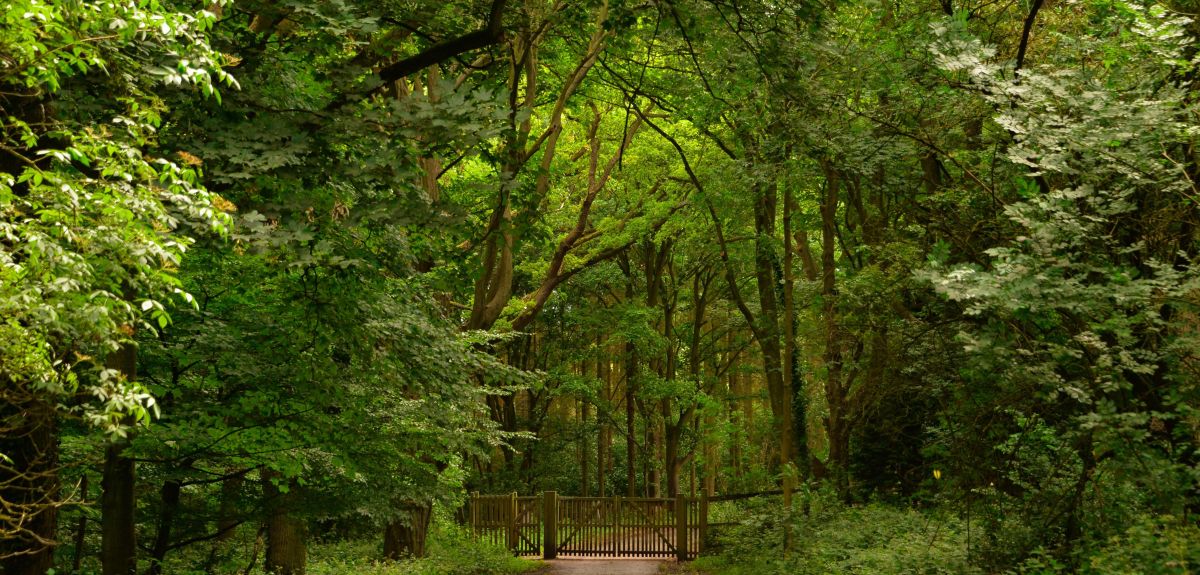

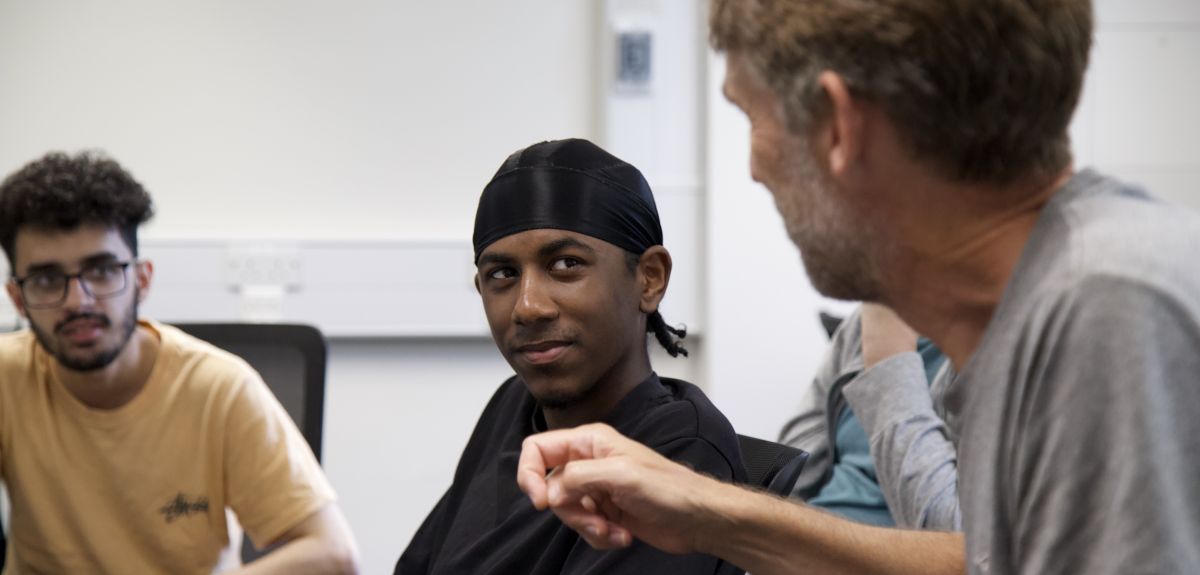
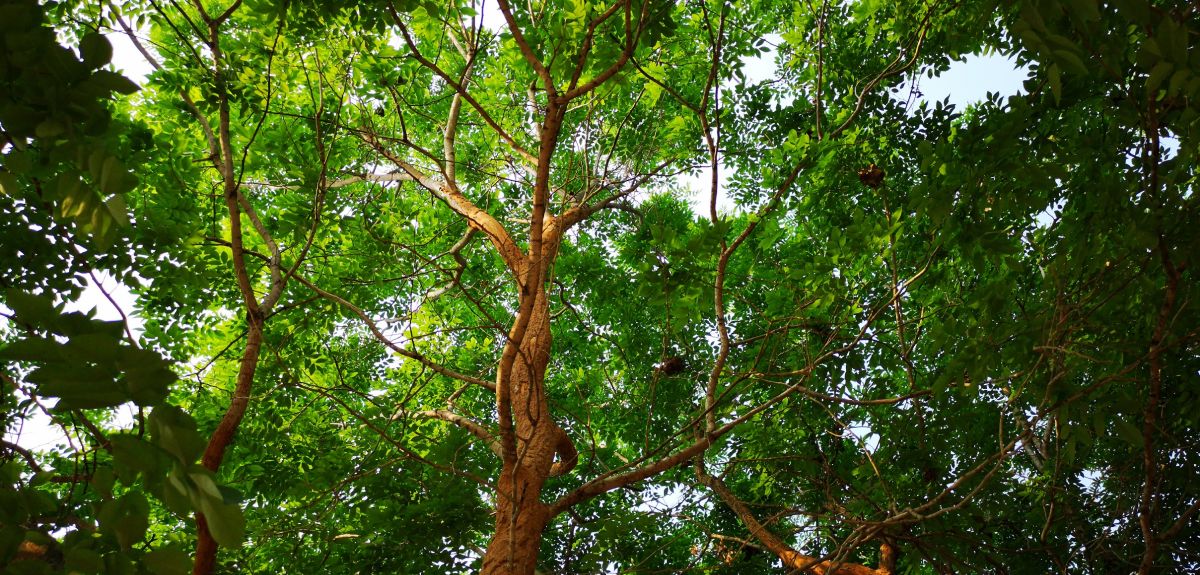
 Teaching the World’s Future Leaders
Teaching the World’s Future Leaders  A blueprint for sustainability: Building new circular battery economies to power the future
A blueprint for sustainability: Building new circular battery economies to power the future Oxford citizen science project helps improve detection of antibiotic resistance
Oxford citizen science project helps improve detection of antibiotic resistance The Oxford students at the forefront of the fight against microbial resistance
The Oxford students at the forefront of the fight against microbial resistance  The hidden cost of AI: In conversation with Professor Mark Graham
The hidden cost of AI: In conversation with Professor Mark Graham  Astrophoria Foundation Year: Dr Jo Begbie reflects on the programme’s first year
Astrophoria Foundation Year: Dr Jo Begbie reflects on the programme’s first year World Malaria Day 2024: an interview with Professor Philippe Guerin
World Malaria Day 2024: an interview with Professor Philippe Guerin From health policies to clinical practice, research on mental and brain health influences many areas of public life
From health policies to clinical practice, research on mental and brain health influences many areas of public life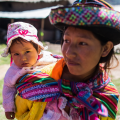 From research to action: How the Young Lives project is helping to protect girls from child marriage
From research to action: How the Young Lives project is helping to protect girls from child marriage